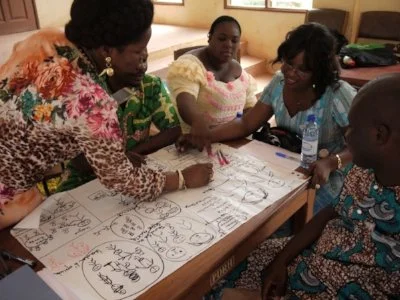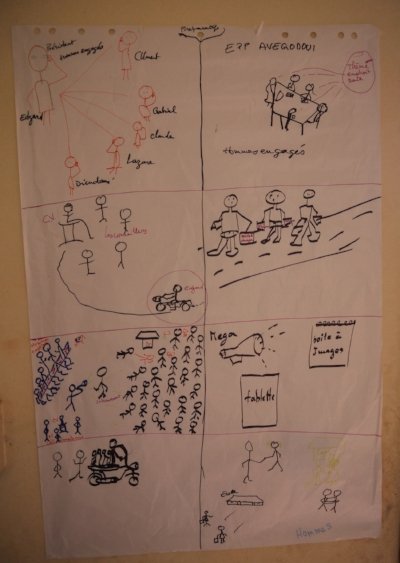Tips And Tools For Creating Educational SMS And WhatsApp Content With Rural Stakeholders
In my previous blog I outlined how and why we planned to run ‘co-creation workshops’ with a varied group of stakeholders in rural Benin, as part of a UNFPA-funded project run by OneWorld to explore strategies to tackle Gender Based Violence (G.B.V.) using ICTs. The stakeholders included rural women and men, youth peer educators, and the heads of social services and civil servants responsible for local response to cases of violence against women and girls.
The main objective for the workshops was to start testing intervention ideas that had emerged from the discovery activities, namely, whether WhatsApp and SMS could be key channels for disseminating information relating to G.B.V., and whether we could get the target audience for the messages to create these messages themselves.
We also wanted to learn more about the target audience’s reality and needs in a more dynamic way than by using focus groups.
Although running such a creative and technical exercise with such varied types of stakeholders was daunting, it was happily a successful experiment, and rich in learnings. In this blog I'm sharing what we learned, as well as advice for anyone considering running something similar. You’ll also find links to the tools we developed for use during the workshops.
Planning Tips
There’s a lot of self-assured posturing in design leadership which you definitely need at the start of a project to create a sense of direction and momentum.
The truth is that in the run up to the workshops, I woke up every morning thinking… ‘Am I crazy?!’. I’d run a decent amount of workshops in the past, but with a very different audience (young urban teens). My main concern was around communication, as we knew the majority of the participants wouldn’t speak French, and many of the women invited were illiterate.
To mitigate these fears I created very detailed activity materials, (available here in French) which included activity objectives, timings, and a script, but also a reminder of the overall objectives as a way to ground us should things veer off track. A well-run workshop is a bit like an impeccable choreography which includes space for free-styling (and in fact…there was a lot of actual impromptu dancing).
Here are some tips if you're facing a similar situation:
No matter how much planning you do, accept that things will go off track. No seriously...accept it. Your driver will get lost, time will run out, babies will pee on the workshop materials…you won’t get round to everything you hoped to.
...That’s why it’s so important to make sure you keep reminding yourself and others of what you’re there to achieve, both in the run up to, and during the workshops. When you need to make changes on the fly, it will help you make the right decisions.
Embrace your printing budget! Print enough copies of your materials, not just for participants but also for facilitators and observers. Don’t scrimp on quality either, as this ICT Works post points out, paper documents are often really appreciated as a tangible outcome of the event (more on this later).
Give yourself a lot of time to take team members through the schedule and activity plans. We hired a translator and a facilitator who would effectively be running the workshop on our behalf, which can be a big risk. We sat down to it at 2pm in muggy heat the day before and didn’t manage to finish prepping, partly because of spending extra time wheedling people’s real opinions out of them.
Involve more people than you think necessary in the planning. Whilst we kept our funder abreast, I regretted not having taken more time to share our plans with other stakeholders such as local authorities. I know, I know, that’s 101 stuff! But with tight deadlines, we all get scared of ’too many cooks’, right? Had I taken this extra step, it probably would have encouraged more active participation and a sense of ownership.
The Workshops: What We Learned
Get Drawing
Five men, one bike...the challenges of community outreach activities.
Once the usual introductions and icebreakers were out of the way (and don’t rush through them; they set the tone for everyone’s participation and are especially important when working through a translator), we kicked off with an activity designed to add detail to things we learned during our discovery interviews, namely, the community outreach activities women, men, and youth were supposedly running.
What do they actually do? How do they prepare? How do their friends and neighbours react? What would they need in order to do things better? We asked participants to create a ‘Before, During, After’ style cartoon strip, using our own workshop preparation process as an example.
What was most striking was how fired up the participants were to take part in such a creative exercise. The reliance on drawing meant that no-one was alienated, and they enjoyed the fact that we were asking them about their experiences and expertise, rather than speaking at them, which had been their experience of workshops in the past.
The exercise had the added benefit of encouraging participants to reflect on their own activities in a critical way, identifying areas where they could do better, or where they might need help.
From our side, we answered one of our big questions, which was whether stakeholders had the appropriate training to run effective outreach activities (no!); we therefore gained a new intervention idea.
The activity also allowed us to validate our idea about using mobile as an outreach tool in a fairly natural way. Without prompting, all the stakeholders mentioned SMS and WhatsApp as a tool they could be using but weren’t, including the women’s groups, some of whom didn’t own a phone.
‘That’s not a problem’, they told us, ‘as long as a few of us have one, we’ll get it done’. At the same time, we could see for ourselves the limited amount of smartphones in use, a classic case of enthusiasm vs practicality.
Writing The Messages
Livestock, education, food, a car, health, love, entertainment...and euros. A depiction of life free from GBV.
As a result of this enthusiasm, the rest of the workshops went off smoothly as we were able to continue with our planned message creation activities.
In all, we created around 35 messages for SMS or WhatsApp. The different stakeholder groups chose the topics and types of violence that were most relevant to them and their peers, wrote some messages with the help of guidelines we’d created, and presented them back to the other groups for discussion, which was also the opportunity to reflect on some of the risks posed by sending messages on taboo-challenging topics.
This enabled us to see, for example, that economic violence was higher up the list than physical or sexual violence for most of the women we spoke to, because it was prevalent across the board, and something they felt the most powerless about.
Because they got to write the messages themselves (the non-literate participants confidently dictating to the scribes in the group), we were able to see not only their choice of language and tone, but also what imagery they chose to complement the text. As part of my planning, I had created a custom emoji pack suitable (I hoped) for a rural Beninese audience, (available here) printing off multiple copies with which to illustrate the messages.
These were a big hit, especially amongst the women, and the workshops came to a triumphant close with the creation of emoji-full vision boards of what a GBV free society would look like.
People Like Learning
Participants really enjoyed the mini-training we ran on ‘How to create good messages’, with many stakeholders requesting extra copies of the cheat sheets we had made (available here). Whilst it's true that participatory, collaborative approaches can yield great results, blending these with some good old fashioned education is wise if you're attempting to create something of good-enough quality.
Again, we were reminded that ICT interventions can take many forms: the provision of high-quality training on how to use the tools available to them might prove a legitimate choice of output for the project.
Social Norms In Action
One of the team’s biggest misgivings about the idea of a ‘co-creation’ session was that we were not giving enough room to the women present to share their stories in a women-only environment.
Whilst it’s true that this would have been valuable from an empathy building perspective, what we got as a result of bringing men, women and youth together was a valuable first-hand observation of the inequitable dynamics between them.
The men imposed themselves on the others from the start, joking loudly that ‘a female president would be a catastrophe’. Our (male) facilitators seemed entirely blind to this dynamic, and we had to step in a few times to try and rectify the power balance.
Bearing in mind that these were men who had received ‘gender training’, it was a stark reminder that to tackle the problem of G.B.V., we need to get to the gnarly root of the problem, namely gender-based social norms. This is not something an ICT intervention alone can take on, but it is the main strategic recommendation we can make to our funders and partners in Benin.
Were The Messages Good Enough?
We were very happy with the overall quality of the messages created, especially those made by the women and youth groups. The messages could at a pinch have been sent out ‘as is’, however because of the sensitive nature of the subject, we went through a second, short vetting process to ensure they would do more good than harm, polishing up the structure and making sure the references to legal texts were accurate, and getting sign off from experts.
We have since then run a small pilot with a WhatsApp group of young peer educators to further test our idea, which will be the subject of my next post.
However daunting it first seemed, co-creating content was overall a success, with participants feeling not only that they had learned something, but that they had taught us something too. As practitioners attempting to identify genuinely useful avenues for intervention, we were able to validate and add nuance to our ideas, and generate new ones as well.
Above all, we were able to get a reality check on the depth and breadth of work needed to tackle the problem of GBV in these communities, which will encourage us to focus in our next phase on establishing the multi-sectoral partnerships necessary to achieve this.
All the materials referenced in this post can be found here (in French) and are available for reuse courtesy of OneWorld and UNFPA Benin. Get in touch with @isabelleamazon if you'd like further guidance!




